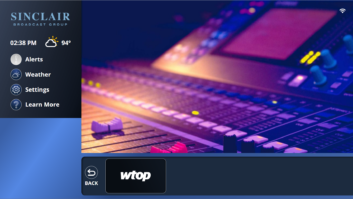Bits are bucks
Nov 1, 2000 12:00 PM, Chriss Scherer
The push to digital facilities continues almost every-where. For radio, this not only includes RF transmission but also transmission via other means. As we evolve into a digital society, one concept is being introduced that redefines how transmitted data is handled. This idea can be summed up simply by saying that bits are bucks. This is a concept that most of the media-content providers have not fully embraced but likely will sooner than later.
The way that radio succeeds commercially has always been based on a payment-per-program or pay-per-format basis. In radio’s early days a single program sponsor was very common. Today, few programs have exclusive sponsorship, but the business model is very similar. I don’t think I need to go into the entire cash flow process here, as I’m sure you are already familiar with the existing ideas. In its most basic form, the current plan for digital radio transmission (IBOC) follows this business model. There are plans in place to allow IBOC to be more than just an aural medium, but these new plans will also require new listening habits.
When transmitting a digital signal of any kind, the transmission is not necessarily a single, complete unit. It is likely a collection of bits that can be part of many larger elements. The bit is the smallest unit of value. The program is no longer the unit.
Traditionally, the program has been the smallest unit. Stations that are part of multiple-station operations have felt the push to maximize revenue from each program. In most cases, this program is the station’s format. The entire broadcast day is considered a unit that can be divided into smaller segments. Revenue is based on the amount billed for the individual avails for each hour and day.
In a digital world, each bit represents a unit of value. Each bit can be part of a larger whole. These bits can be audio, video, data or anything else. As the data pipeline grows, the number of available bits also increases.
Telecommunications carriers and ISPs have already begun considering their available bits as revenue units. Telcos have already established that the monthly charge for an ISDN line is less than that for a T1. Data carriers have been working under this model for some time. In this case, you are paying for the bit capacity instead of the bit usage, but it still qualifies as a bits-are-bucks idea. It’s certainly more convenient for them to charge based on capacity rather than the actual data throughput.
Radio is a newcomer into this bit arena. We control our bits and their transmission completely. IBOC continues this idea but adds new ways for these bits to be used, and newer transmission methods will bring new ways to use these bits. Future transmission technologies may not allow the complete control by the content creators that exists now. Already, Internet radio is making that obvious. Once the stream is digitized, there is no station control over the bitstream.
As wireless Internet technology becomes more common, and the wireless service providers increase their data capacities, radio may see less need to control its own transmission facilities. When this happens, the exact value of each bit will be easy to recognize. Radio will turn more to content creation and away from distribution. Each bit created will have an established value and a content creator’s revenue will be based on each transmitted bit.








